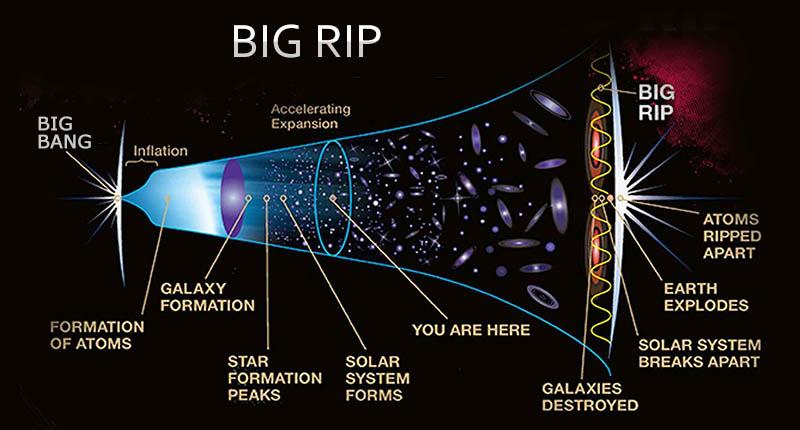- Understanding the Big Rip Theory: An Introduction to the End of the Universe
- The Expansion of the Universe and the Big Rip: How They Are Connected
- Could the Big Rip be the Ultimate Fate of the Universe?
- The Physics of the Big Rip: How it Works and Why it Matters
- What Would Happen If the Big Rip Theory Turned Out to Be True?
- The Debate Over the Big Rip Theory: Criticisms and Alternative Hypotheses
- From the Big Bang to the Big Rip: The Evolution of the Universe
- The Role of Dark Energy in the Big Rip Theory: What We Know and What We Don’t
- Can We Predict the Timing of the Big Rip?
- The Big Rip and the Search for a Theory of Everything
- Conclusion.
The Big Rip Theory: An Introduction to the End of the Universe
Have you ever wondered what will happen to the universe in the far future? According to the Big Rip theory, the universe will eventually meet its end in a dramatic way.
The Big Rip theory proposes that the expansion of the universe will continue to accelerate until it reaches a point where the gravitational forces that hold matter together are overpowered. This means that even galaxies, stars, and eventually atoms will be torn apart, resulting in a universe filled with only elementary particles.
While the idea of the universe ending in such a way may seem frightening, it’s important to note that the Big Rip theory is still just a hypothesis. However, the theory is gaining increasing attention among cosmologists as an intriguing possibility.
The Big Rip theory is based on our current understanding of dark energy, a mysterious force that is causing the expansion of the universe to accelerate. The theory suggests that the rate of expansion will continue to increase until it reaches an exponential growth rate. At this point, the force of dark energy will be strong enough to overcome the gravitational forces that hold objects together, resulting in the Big Rip.
While the Big Rip may seem like a distant event, it’s important to continue researching and studying this theory as it provides insight into the fundamental forces and properties of the universe. It also raises important questions about the ultimate fate of our universe and what lies beyond.
The Connection Between the Expansion of the Universe and the Big Rip
The universe is constantly expanding, and this expansion is one of the most fundamental processes in cosmology. But did you know that the expansion of the universe is also closely linked to the Big Rip theory?
The expansion of the universe refers to the phenomenon in which the distance between galaxies and other cosmic objects is increasing over time. This phenomenon was first observed in the 1920s by astronomer Edwin Hubble, and has since been confirmed by numerous observations and experiments.
The cause of the universe’s expansion is believed to be dark energy, a mysterious force that permeates all of space and is pushing the universe apart. While dark energy remains poorly understood, it’s believed to be responsible for the accelerated expansion of the universe that has been observed in recent years.
So, how does the expansion of the universe relate to the Big Rip theory? The Big Rip theory proposes that the expansion of the universe will continue to accelerate until it reaches a point where the gravitational forces holding matter together are overpowered. This means that everything, from galaxies to stars to atoms, will be torn apart.
The relationship between the expansion of the universe and the Big Rip theory is based on the assumption that dark energy will continue to drive the universe’s expansion. As the expansion accelerates, the distance between cosmic objects will increase at an even faster rate, eventually leading to the Big Rip.
However, it’s important to note that the Big Rip theory is just one possibility for the ultimate fate of the universe. Other theories, such as the Big Crunch or the Heat Death, propose different outcomes for the universe’s expansion.
Could the Big Rip be the Ultimate Fate of the Universe?
The Big Rip theory proposes a dramatic and cataclysmic end to the universe, in which everything from galaxies to stars to atoms will be torn apart by the force of dark energy. But could this really be the ultimate fate of the universe?
While the Big Rip theory remains a hypothesis, it’s gained significant attention and support among cosmologists in recent years. The theory is based on our current understanding of dark energy, a mysterious force that’s causing the universe’s expansion to accelerate.
According to the Big Rip theory, dark energy will continue to drive the universe’s expansion until it reaches an exponential growth rate. At this point, the force of dark energy will become so strong that it will overcome the gravitational forces holding matter together, resulting in the Big Rip.
So, could the Big Rip really be the ultimate fate of the universe? It’s difficult to say for certain, as there are still many unknowns about dark energy and the nature of the universe.
One possible alternative to the Big Rip is the Heat Death theory, which suggests that the universe will eventually reach a state of maximum entropy, in which all matter is evenly distributed and there’s no energy left for the universe to continue expanding. This would result in a universe that’s cold, dark, and devoid of any activity.
Another possibility is the Big Crunch theory, which suggests that the universe will eventually stop expanding and begin contracting until everything collapses into a single point of infinite density known as the singularity.
Despite the uncertainties, the Big Rip theory remains a fascinating and thought-provoking possibility for the ultimate fate of the universe. It raises important questions about the nature of dark energy, the fundamental forces of the universe, and the potential limits of our scientific understanding.
The Physics of the Big Rip: Understanding its Mechanics and Significance
The Big Rip is a fascinating and dramatic theory that proposes the ultimate fate of the universe. But how does it work, and why does it matter from a physics perspective?
At the heart of the Big Rip theory is the concept of dark energy, a mysterious force that’s causing the universe’s expansion to accelerate. While the exact nature of dark energy is still unknown, it’s believed to be responsible for the continued expansion of the universe.
As the universe expands, the distance between cosmic objects increases. This is because space itself is expanding, pushing everything apart. However, the force of gravity is still present, attempting to pull everything back together.
In the case of the Big Rip, dark energy becomes so strong that it overpowers the force of gravity, causing the universe’s expansion to accelerate at an exponential rate. As the acceleration increases, the distance between cosmic objects will increase even more rapidly until they are eventually torn apart, from galaxies to stars to even atoms.
From a physics perspective, the Big Rip is significant because it challenges our understanding of fundamental forces and the nature of the universe. It suggests that dark energy, which we still know very little about, could be a dominant force that ultimately shapes the fate of the universe.
Furthermore, the Big Rip raises important questions about the fundamental laws of physics and how they operate on a cosmic scale. It forces us to consider the potential limits of our current scientific understanding and the need for continued research and exploration.
In addition, the Big Rip has implications for the study of dark energy, which remains one of the biggest mysteries in astrophysics. Understanding the mechanics of the Big Rip could provide valuable insights into the nature and behavior of dark energy, potentially unlocking new avenues of research and discovery.
What If the Big Rip Theory is True? Exploring the Catastrophic End of the Universe
The Big Rip theory proposes a catastrophic end to the universe in which everything, from stars to galaxies to atoms, will be torn apart by the force of dark energy. While the theory remains speculative, if it were to turn out to be true, what would happen?
If the Big Rip were to occur, it would happen quickly and without warning. As the universe’s expansion continues to accelerate, the distance between objects would rapidly increase until it surpasses the force of gravity. Eventually, the force of dark energy would become so strong that it would overpower all other forces in the universe, including the strong and weak nuclear forces that hold atoms together.
As a result, the fabric of the universe itself would be torn apart, and everything in it, including planets, stars, and even black holes, would be ripped apart into their component particles. The universe would become a vast, empty void with no structure or matter left in it.
The implications of the Big Rip are profound, and if it were to turn out to be true, it would fundamentally change our understanding of the universe and the laws of physics that govern it.
One of the biggest implications is that it would put a hard limit on the potential for advanced civilizations to exist in the universe. With the universe tearing itself apart at an accelerating rate, any advanced civilization that arose would have only a limited amount of time to exist and develop before being destroyed.
In addition, the Big Rip would have a profound impact on our understanding of cosmology and astrophysics. It would challenge many of our current theories and models of the universe, and would require a new understanding of the fundamental laws of physics.
However, despite the catastrophic implications of the Big Rip, there is still much we don’t know about the nature of dark energy and the ultimate fate of the universe. Other possibilities, such as the Heat Death or the Big Crunch, may still be viable options.
The Big Rip Theory: Debating its Validity and Alternative Hypotheses
The Big Rip theory proposes a dramatic and catastrophic end to the universe, but not everyone in the scientific community agrees with its validity. In fact, there are several criticisms and alternative hypotheses that challenge the Big Rip’s assumptions.
One of the primary criticisms of the Big Rip theory is that it relies on the assumption that dark energy will continue to accelerate the universe’s expansion. However, the nature of dark energy is still not fully understood, and it’s possible that it may behave differently than what the theory proposes.
Another criticism is that the Big Rip theory ignores the effects of gravity. While dark energy may be causing the universe to expand at an accelerating rate, gravity still plays a significant role in shaping the structure of the universe. Some researchers have proposed alternative hypotheses that take into account both dark energy and gravity.
One alternative hypothesis is the “big freeze” theory, also known as the “Heat Death” of the universe. This theory proposes that the universe will continue to expand, but at a slower rate than the Big Rip suggests. As a result, the universe will eventually become cold and dark, with no available energy left to sustain life or matter.
Another alternative hypothesis is the “big crunch” theory, which suggests that the universe will eventually stop expanding and begin to contract, leading to a catastrophic collapse that would ultimately lead to a new Big Bang.
Despite these criticisms and alternative hypotheses, the Big Rip theory remains a fascinating and important area of study in astrophysics. By continuing to explore the mechanics and implications of the Big Rip, researchers can gain a deeper understanding of the universe and the forces that shape its destiny.
Ultimately, whether or not the Big Rip theory is proven true or false, the ongoing debate and exploration surrounding it highlights the importance of scientific inquiry and the necessity of constantly challenging and reevaluating our current understanding of the universe.
From the Big Bang to the Big Rip: Tracing the Evolution of the Universe
The universe has been in a constant state of evolution since its birth in the Big Bang. Over the past 13.8 billion years, the universe has undergone countless changes, from the formation of galaxies and stars to the emergence of life on Earth. However, the ultimate fate of the universe is still a topic of much debate and speculation, with theories such as the Big Rip, Heat Death, and Big Crunch all offering different possible outcomes.
The universe began as a hot, dense, and infinitely small singularity that exploded in a massive burst of energy, creating all matter and energy in the universe. For the first few moments after the Big Bang, the universe was filled with a dense plasma of particles that were constantly colliding with each other, forming atoms and molecules.
As the universe cooled, the particles began to form into clouds of gas, which eventually coalesced into the first galaxies and stars. Over billions of years, these galaxies and stars interacted with each other, shaping the structure of the universe as we know it today.
However, the expansion of the universe is still ongoing and accelerating, driven by the mysterious force known as dark energy. This acceleration will eventually lead to the separation of all matter in the universe, ultimately leading to the Big Rip or other possible outcomes.
Despite the uncertainty surrounding the ultimate fate of the universe, the journey of the universe from the Big Bang to the present day is a remarkable and awe-inspiring story. It showcases the incredible power of the laws of physics and the forces that shape our world, and reminds us of the ever-changing and evolving nature of the universe around us.
As we continue to explore and understand the universe, from the smallest particles to the largest structures, we gain a deeper appreciation for the complexity and beauty of the cosmos. And even if the universe does end in a catastrophic event such as the Big Rip, the journey of the universe will remain a testament to the remarkable history and evolution of the cosmos.
The Role of Dark Energy in the Big Rip Theory: Unraveling What We Know and What We Don’t
Dark energy is one of the most mysterious and perplexing concepts in astrophysics. It is believed to be the driving force behind the accelerating expansion of the universe and plays a critical role in the Big Rip theory. But despite its importance, we still don’t know much about what it is or how it works.
One of the leading theories about dark energy is that it is a property of space itself, known as the cosmological constant. This constant exerts a negative pressure on the universe, causing it to expand at an accelerating rate. However, this theory still raises many questions, including why the cosmological constant has the value that it does.
Another theory proposes that dark energy is caused by a new fundamental force in nature, known as quintessence. This force would have a variable strength and could potentially explain why dark energy is accelerating the universe’s expansion.
While dark energy remains a mystery, its role in the Big Rip theory is clear. The theory proposes that as the universe continues to expand, the force of dark energy will grow stronger and eventually overcome the force of gravity. This will lead to a rapid and catastrophic expansion that will tear apart all matter in the universe, ultimately resulting in the end of the universe.
Despite the uncertainties surrounding dark energy and the Big Rip theory, they remain crucial areas of research in astrophysics. By continuing to study and understand these concepts, we can gain deeper insights into the fundamental forces that shape our universe and ultimately, our place in it.
Can We Predict the Timing of the Big Rip? Exploring the Limits of our Understanding
The Big Rip theory proposes that the universe will eventually come to a catastrophic end, with all matter being torn apart by the force of dark energy. But can we predict when this will happen?
The short answer is that we simply don’t know. While we have a good understanding of the physics behind the Big Rip, there are still many uncertainties that make it impossible to accurately predict the timing of this event.
One of the main uncertainties is the value of the cosmological constant, which determines the strength of the force of dark energy. While we have measured this value to be nonzero, we still don’t know precisely what it is or why it has the value that it does. This makes it difficult to predict how quickly dark energy will accelerate the expansion of the universe and ultimately lead to the Big Rip.
Another factor is the distribution of matter in the universe. While we have a good understanding of the overall structure of the universe, there are still many unknowns about the distribution of matter on smaller scales. This can affect the rate of expansion and potentially impact the timing of the Big Rip.
Despite these uncertainties, astrophysicists continue to work on refining our understanding of the Big Rip and its potential timing. One approach is to use computer simulations to model the evolution of the universe and test different scenarios for the behavior of dark energy. This can help us gain a better understanding of the possible outcomes and limitations of the Big Rip theory.
The Big Rip and the Search for a Theory of Everything: How Astrophysics and Particle Physics are Linked
The Big Rip theory has captured the imagination of astrophysicists and cosmologists for years, but it also has implications for the search for a theory of everything, which seeks to unify all of the fundamental forces of nature into a single, cohesive framework.
One of the main challenges in developing a theory of everything is reconciling the laws of quantum mechanics, which govern the behavior of particles on a small scale, with the laws of general relativity, which describe the behavior of gravity on a large scale. While both of these theories have been incredibly successful in their respective domains, they seem to be incompatible with each other.
The Big Rip theory could potentially offer some insights into this problem. As the universe expands and dark energy becomes more dominant, the force of gravity becomes weaker. This could provide a natural laboratory for testing theories that attempt to unify gravity with other fundamental forces, such as string theory or loop quantum gravity.
Another way that the Big Rip could help in the search for a theory of everything is by providing a potential endpoint for the universe. By studying the behavior of matter and energy in the extreme conditions of the Big Rip, physicists could gain insights into the fundamental properties of matter and the nature of the universe itself.
Conclusion
In conclusion, the Big Rip theory is a fascinating and complex idea that has captured the imagination of scientists and enthusiasts alike. While there is still much that we don’t know about the physics behind the Big Rip, astrophysicists and cosmologists continue to work on refining our understanding of this potential catastrophic event. The Big Rip has important implications for our search for a theory of everything, as it provides a natural laboratory for testing fundamental theories of gravity and could potentially offer insights into the nature of the universe itself. Despite the uncertainties, the study of the Big Rip is an exciting and important area of research that will continue to shape our understanding of the universe for years to come.
ScitechVenture YouTube Link







